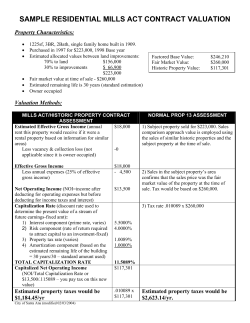
Wisconsin Historic Tax Credits - Milwaukee Preservation Alliance
Wisconsin Historic Tax Credits – FAQ March 25, 2015 Q: What is the Wisconsin Historic Tax credit program? A: Wisconsin’s historic tax credit program is an economic engine that stimulates investment and creates jobs. In 1981, the federal government began providing a historic rehabilitation tax credit as an incentive to leverage private investment in the preservation of historic buildings. In 1990, Wisconsin launched a companion historic tax credit program, offering a 5 percent tax credit covering 100% of qualified rehabilitation expenses once the building was placed into service. On Jan. 1, 2014 the tax credit was elevated to 20 percent. Q: How does it work? To qualify, a property must be a “certified historic structure” meeting the stringent criteria for listing on the State Register and the National Register of Historic Places. The project must involve the rehabilitation of the building for an income-producing use and meet a minimum investment test. Construction must meet the Secretary of Interior’s Standards for Rehabilitation and be approved by the National Park Service and the Wisconsin State Historic Preservation Office. Q: What is the Return on Investment (ROI?) A: Since January 2014, $35 million in tax credits have leveraged $211 million in private investment expenditures in 31 historic tax credit projects. Researchers at the University of Wisconsin-Milwaukee estimate these projects will generate $20.3 million in annual state tax revenue through 4,062 created jobs at $5,000 in state taxes generated per job. Additionally, it is estimated that $209 million in salary will be paid to the more than 4,000 workers filling the newly created jobs ($46,218 avg. salary).1 Q: Is this program used throughout the state? A: In 2014 alone, the increased tax credit brought new rehabilitation activity to communities across the state including: Ashland, Baraboo, Dodgeville, Eau Claire, Janesville, Kaukauna, Kenosha, Green Bay, La Crosse, Madison, Manitowoc, Mauston, Mayville, Milwaukee, Monroe, Oshkosh, Portage, Rice Lake, Sauk City, Schofield, Shawano, Sheboygan, Sun Prairie, and Waukesha. Q: How is the state paid back on its investment? A: Ultimately, the HTC program results in increased tax revenue through job creation and taxes paid by the businesses locating in formerly abandoned or underutilized buildings. Locally, it results in higher property values – which can increase by a factor 5 to 10 times. Moreover, independent studies show one-third of the state’s investment is paid back during the construction phase. For example, the Maryland Governor’s Task 1 Economic and Job Creation Report, 2014 Wisconsin Historic Tax Credits, University of Wisconsin-‐Milwaukee, March 2013. Note: A report from the accounting firm, Baker Tilley Virchow Krause, LLP using the IMPLAN economic model is underway. Force on their historic tax credit program found that for every $1 offered in tax credits, $0.34 was returned to the state prior to any credit being paid out because of taxes on labor and materials.2 Cleveland State University found that for every $1 invested by Ohio, $.33 was returned during the construction phase because of state taxes on labor and materials.3 Q: How have HTCs made Wisconsin more competitive in attracting development? A: Developers focus their private investment and redevelopment activity in those states with the strongest historic tax credit programs. With the 20 percent credit in place, Wisconsin has become much more competitive with neighboring states that have traditionally attracted more HTC investment in historic development projects. 2 3 Final Report of the Governor’s Taskforce on Maryland’s Heritage Structures Rehabilitation Tax Credit, 2004 http://www.development.ohio.gov/files/redev/OHPTC%20Economic%20Impact%20Study%20-‐%20May%202011.pdf
© Copyright 2025



















